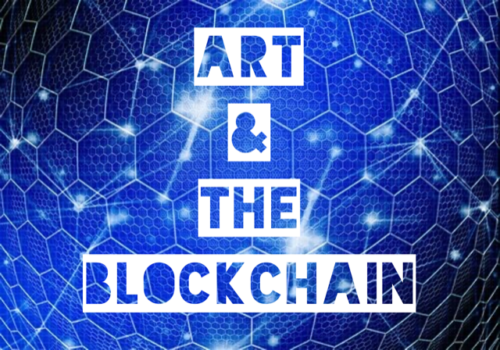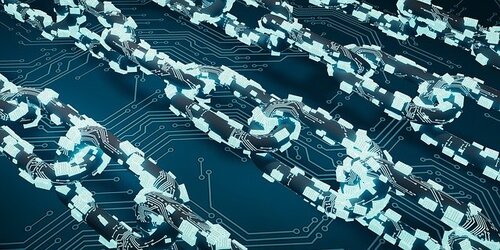by Carolyn Edlund
Blockchain is affecting the art industry, small business, and our lives in general. Here’s what artists should know about this evolving technology.

Art as NFTs and the rise of the crypto art market have been all over the news lately. Headlines scream about artists earning veritable fortunes overnight, while others warn about energy usage. Some artists are clamoring to get involved with this hot new market. Others are vehemently opposed.
What is the future of NFTs and the blockchain technology behind them? I spoke with two experts to get answers and dive into big changes coming to the industry.
Why Blockchain Matters
Blockchain is a “trustless” protocol that records transactions through a transparent, verifiable ledger system which cannot be altered. The entire cryptocurrency market and a myriad of virtual tools and projects are built on blockchain platforms that provide fast, accurate and safe functionality.
Importantly, blockchain is a decentralized system which is disrupting the status quo. It tends to increase fairness and stability, and take power out of the hands of a small group of decision makers. In this way, blockchain mirrors the art industry itself, which has fractured and placed more control in the hands of self-determining individual artists.
To get to the heart of the enormous impact this will have in our everyday lives, I spoke with Shidan Gouran. He is an early blockchain investor and a serial technology entrepreneur holding degrees in Pure Mathematics and Theoretical Physics from the University of Western Ontario. Gouran is the founder of Gulf Pearl, a Canadian merchant bank focused on financing both private and junior public companies in the information, communications and media sectors.
“Blockchain is now mainstream,” Gouran says. “Technologies come and go, and better technologies will come. The concept of universal databases that anybody can read and write to and that cannot be manipulated are very useful. Digital assets are here to stay. It just makes sense that things would move from paper to the digital world. Tracking and provenance of real world objects on the internet will become more and more common. Those are the realities.”
How prevalent is blockchain in our society? One third of small and medium-sized businesses now take cryptocurrency as payment. Bitcoin can be purchased using Paypal. Mastercard, Visa, and American Express are all embracing blockchain technology. It is transforming the banking and financial industries, and is the “digital DNA” of the internet 3.0.
The Question of Energy Consumption
Blockchain is undergoing rapid evolution and improvement. Detractors cite as a major concern the high energy usage in the “mining” process that drives transactions. Bitcoin is often held up as a major example of this excess.
“Bitcoin was the first prototype; it is not the last system in existence,” explains Gouran. “Right now it consumes more energy than the Netherlands. Each transaction burns more than 700,000 Visa transactions as far as energy goes. When you consider these things, Bitcoin is not a great system. In my opinion, if it became the world’s currency it would be highly immoral, because of the energy consumption.”
How will this problem be overcome? Bitcoin operates on a Proof of Work mechanism which is energy inefficient. The Ethereum blockchain (which powers NFTs) and other platforms are moving to Proof of Stake, which is much less energy consumptive.
Gouran adds, “There are systems like Stellar and Ripple and when released, Facebook’s Diem blockchain, which would use even less energy than Ethereum’s Proof of Stake. A transaction on the Diem blockchain doesn’t cost more than a Visa transaction.”
Think of super efficient systems underlying the technology of finance and business that remove the need for offices full of workers using energy to validate and push through transactions. What are the energy savings when you don’t have to power 100,000 square foot buildings using light and heat and computers for hundreds of workers because they aren’t needed, all due to blockchain efficiency? We could end up with an actual decrease in energy usage.

Art as NFTs
NFTs (art sold as non-fungible tokens) have captured the imagination of the world and produced record-breaking sales. I asked art advisor, curator and crypto expert Georg Bak about this phenomenon. He says, “NFTs are certainly not just a trend. I believe that this market has a huge growth potential, not only for art but also for any kind of collectibles in the game, fashion and sport industry. At the moment the market is a bit overheated and many buyers are only buying NFTs in order to flip them instantaneously and make profits. I believe we will see a correction towards a more consolidated and matured market. There are so many historical digital artworks which never had a market and can be discovered by a wider public.”
What does this mean for the individual artist? Selling platforms are cropping up like wildfire, offering an opportunity to artists who want to enter the crypto art market. Over time it will shake out and mature, and providers will address some of the existing technical limitations. Right now the sky is the limit. Once we have some history in the rearview mirror, the road will become clearer.
Benefits of New Tech
New technologies built on blockchain and the “smart contracts” they enforce offer a level of transparency to an often opaque art world. This is good news for artists who create both digital and physical artworks, which can be embedded and tracked.
Bak says, “Blockchain technology will certainly not solve the authenticity and provenance issues of the past, but it can have a strong impact on future transactions. Nevertheless the data on the blockchain is only valuable if the physical artwork can be identified and assigned clearly to the data. There are different methods to apply identifiers such as for example RFID chips or surface scanning technologies.”
Once embraced, chips and scanning methods can assure the authenticity, scarcity and provenance of an individual piece of art. Artists will also use blockchain technology to track inventories, collectors, shipping and sales transactions. Another huge benefit of smart contracts is automatic payment of royalties to artists when secondary sales of their work are made.
Power to the Artists
As decentralization continues to put more control into the hands of individual artists, they are no longer in thrall to gatekeepers or third parties. How will our industry evolve as the power centers change?
“Galleries are certainly losing their monopoly over the market as artists can reach out to collectors directly,” says Bak. “The new gatekeepers are online marketplaces, and power is shifting from galleries to platforms. Even though platforms provide an interesting new revenue stream for artists, they don’t necessarily provide the same extent of curatorial exposure and content for artists as gallerists did in the past. Quite often platforms select artists according to purely mathematical measures, such as the number of followers on Instagram. Therefore, I think that galleries or artist managers are still playing an important role in promoting the artist’s career but probably they have to reinvent their business model.”
Want to stay current on cutting edge business articles from Artsy Shark, plus artist features, and an invitation to the next Call for Artists? Subscribe to our twice-monthly Updates, and get a free e-book on Where to Sell Art Online right now!

I read the whole article and didn’t understand a word of it! What is an NFT? What is a non fungible token? Is it real art sold using a digital currency or is it digitized art? I wonder how many actual artists understood this article.
Anna, You can get started by reading our earlier article “What is Crypto Art?” https://www.artsyshark.com/2021/03/03/what-is-the-crypto-art-market/ which was linked to in this article. NFTs are real art in digital form sold using digital currency. However, physical art can also have an NFT connected with it.
Thanks for this report on blockchain and art. I am not a digital artist (yet, who knows?) but can see the implications of this new system. I must say the prospect of the success of anyone’s art being in the hands of algorithms and “likes”on Instagram doesn’t sound more fair than what is happening now. I regret the de-humanization of the whole process. Art – for me – is among other things a vehicle for deep connections between humans and their experiences. A sort of emotional chain between the creator and the collector, made of links like visual impressions, ideas, desires, talent, admiration, beauty, memories and probably also pure gut feeling. To see it reduced to a commodity on virtual platforms doesn’t feel right. But then, maybe – and hopefully, digital art will never be able of replace centuries of physical art.
Thank you so much for the article, Carolyn. However, I agree with Ilse Taylor Hable. Digital art will probably grow more but will never replace physical art, as the e-books did not replace printed books and the 3d animated movies can’t replace the movies we all love to watch…
I don’t disagree with you Nicholas, or with Ilse. Digital art is an entirely different animal, and many people would not own NFTs. Still, it’s good to know what is in the marketplace. Blockchain technology, however, has very real implications for physical art. They can be embedded with NFTs, which track the ownership of the work, and may have a smart contract that pays the artist on secondary sales. Blockchain will speed financial transactions, track inventories and shipping, and maintain permanent and non-alterable records. So this technology is not all about selling .jpgs online. It is the underpinning to tools which will make all of our lives easier.
Thank you for this article. I am a painter and have 3 “mined” images. It did cost a lot but I justified it with how in the past, before I had a high res digital camera, would pay a photographer about the same amount per image of digital capture. NFT does have the energy controversial aspect, I mined before I knew this so am ok with the ethics. We are aware, and as most artists I know, ethics is important to the creative spirit. Awareness is the 1st step in making change. I will continue to make “them” but will be seeking out to “publish/mine” on platforms that are popping up that do not mine until sold at least…will see how it goes.
Hi Deb, and thanks for your comment about the process of creating an NFT. This new market is going through a lot of changes and providers are devising ways to reduce energy cost.
Artists who are looking for “eco-friendly” platforms that do not use the Ethereum blockchain can find a list of them here https://github.com/memo/eco-nft